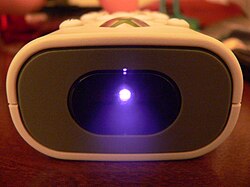Infrared

Infrared (IR) radiation is a type of electromagnetic radiation (a wave with electricity). The wave is longer than light which humans can see and shorter than microwaves. The word infrared means below red. It comes from the Latin word infra (meaning below) and the English word red. (Infrared light has a frequency below the frequency of red light). Red light has the longest wavelength that human eyes can see. Infrared waves cannot be seen by the eye.
Near-infrared waves are between 800 nm and 1.4 µm. Most infrared from the Sun is near-infrared. Thermal imaging is mostly done with thermal radiation waves between 8 and 15 µm.
People sense infrared as heat.
Most remote controls use infrared to send the control signals. Many missiles for anti-aircraft warfare find their target by infrared.
Telecommunications
Before Bluetooth was invented, some computers, personal digital assistants, and cell phones used infrared technology to send files to other devices. Bluetooth replaced infrared in the early 2000s. Infrared is limited by the need to have both devices in a "line of sight" with each other.[1]
Infrared lasers are used to provide the light for optical fiber communications systems. Infrared light with a wavelength around 1,330 nm (least dispersion) or 1,550 nm (best transmission) are the best choices for standard silica fibers.
Infrared Media
Materials with higher emissivity appear closer to their true temperature than materials that reflect more of their different-temperature surroundings. In this thermal image, the more reflective ceramic cylinder, reflecting the cooler surroundings, appears to be colder than its cubic container (made of more emissive silicon carbide), while in fact, they have the same temperature.
Active-infrared night vision: the camera illuminates the scene at infrared wavelengths invisible to the human eye. Despite a dark back-lit scene, active-infrared night vision delivers identifying details, as seen on the display monitor.
Thermography helped to determine the temperature profile of the Space Shuttle thermal protection system during re-entry.
Infrared light from the LED of a remote control as recorded by a digital camera
Infrared hair dryer for hair salons, c. 2010s
Related pages
References
- ↑ Bedell, Doug (2002-08-29) (NewsBank). Electronics unplugged - Bluetooth radio technology becoming reality in cellphones, printers, PDAs, headsets .... p. 3D. http://docs.newsbank.com/openurl?ctx_ver=z39.88-2004&rft_id=info:sid/iw.newsbank.com:AWNB:DMNB&rft_val_format=info:ofi/fmt:kev:mtx:ctx&rft_dat=0F5BDC0337F96215&svc_dat=InfoWeb:aggregated5&req_dat=0EAD847D4966C8AF. Retrieved 2010-12-13.







